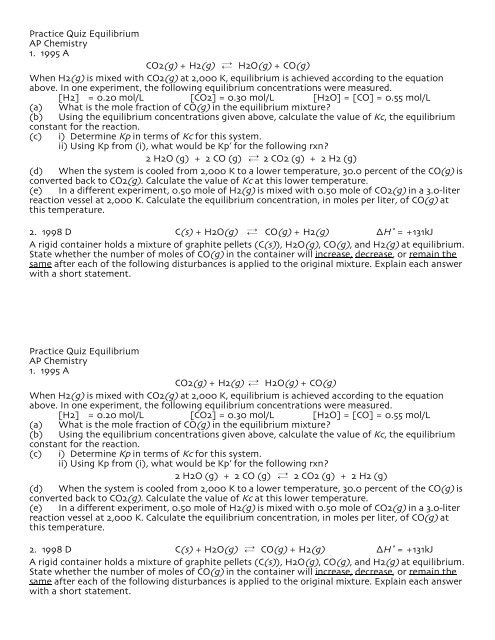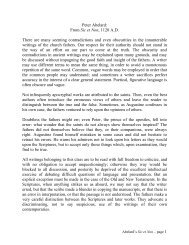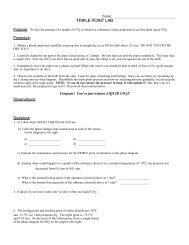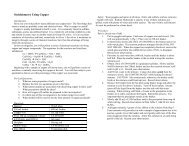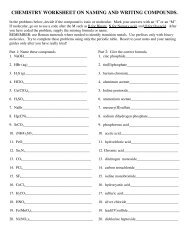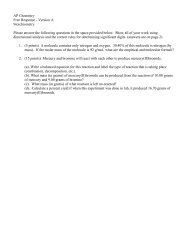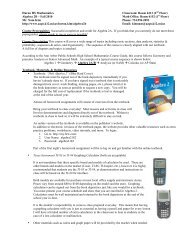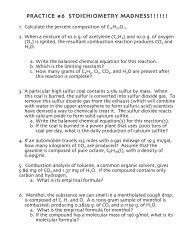Practice Quiz Equilibrium
Practice Quiz Equilibrium
Practice Quiz Equilibrium
- No tags were found...
Create successful ePaper yourself
Turn your PDF publications into a flip-book with our unique Google optimized e-Paper software.
<strong>Practice</strong> <strong>Quiz</strong> <strong>Equilibrium</strong>AP Chemistry1. 1995 ACO2(g) + H2(g) H2O(g) + CO(g)When H2(g) is mixed with CO2(g) at 2,000 K, equilibrium is achieved according to the equationabove. In one experiment, the following equilibrium concentrations were measured.[H2] = 0.20 mol/L [CO2] = 0.30 mol/L [H2O] = [CO] = 0.55 mol/L(a) What is the mole fraction of CO(g) in the equilibrium mixture?(b) Using the equilibrium concentrations given above, calculate the value of Kc, the equilibriumconstant for the reaction.(c)i) Determine Kp in terms of Kc for this system.ii) Using Kp from (i), what would be Kp’ for the following rxn?2 H2O (g) + 2 CO (g) 2 CO2 (g) + 2 H2 (g)(d) When the system is cooled from 2,000 K to a lower temperature, 30.0 percent of the CO(g) isconverted back to CO2(g). Calculate the value of Kc at this lower temperature.(e) In a different experiment, 0.50 mole of H2(g) is mixed with 0.50 mole of CO2(g) in a 3.0-literreaction vessel at 2,000 K. Calculate the equilibrium concentration, in moles per liter, of CO(g) atthis temperature.2. 1998 D C(s) + H2O(g) CO(g) + H2(g) ∆H˚ = +131kJA rigid container holds a mixture of graphite pellets (C(s)), H2O(g), CO(g), and H2(g) at equilibrium.State whether the number of moles of CO(g) in the container will increase, decrease, or remain thesame after each of the following disturbances is applied to the original mixture. Explain each answerwith a short statement.<strong>Practice</strong> <strong>Quiz</strong> <strong>Equilibrium</strong>AP Chemistry1. 1995 ACO2(g) + H2(g) H2O(g) + CO(g)When H2(g) is mixed with CO2(g) at 2,000 K, equilibrium is achieved according to the equationabove. In one experiment, the following equilibrium concentrations were measured.[H2] = 0.20 mol/L [CO2] = 0.30 mol/L [H2O] = [CO] = 0.55 mol/L(a) What is the mole fraction of CO(g) in the equilibrium mixture?(b) Using the equilibrium concentrations given above, calculate the value of Kc, the equilibriumconstant for the reaction.(c)i) Determine Kp in terms of Kc for this system.ii) Using Kp from (i), what would be Kp’ for the following rxn?2 H2O (g) + 2 CO (g) 2 CO2 (g) + 2 H2 (g)(d) When the system is cooled from 2,000 K to a lower temperature, 30.0 percent of the CO(g) isconverted back to CO2(g). Calculate the value of Kc at this lower temperature.(e) In a different experiment, 0.50 mole of H2(g) is mixed with 0.50 mole of CO2(g) in a 3.0-literreaction vessel at 2,000 K. Calculate the equilibrium concentration, in moles per liter, of CO(g) atthis temperature.2. 1998 D C(s) + H2O(g) CO(g) + H2(g) ∆H˚ = +131kJA rigid container holds a mixture of graphite pellets (C(s)), H2O(g), CO(g), and H2(g) at equilibrium.State whether the number of moles of CO(g) in the container will increase, decrease, or remain thesame after each of the following disturbances is applied to the original mixture. Explain each answerwith a short statement.
PRACTICE QUIZ/EQUILIBRIUM ANSWERS:1995 A________________________________________________________________________________A) 0.55 + 0.55 + 0.30 + .20 = 1.6molL -1 CO = 0.55 molL -1 .55/1.6 = 0.34 = X COB) Kc =[CO][H2O] = [.55][.55] = Kc = 5.0[CO2][H2] [.30][.20]C) (i) Kp = Kc(RT) Δn Δn = 0 So, Kp = Kc = 5.0(ii) The reaction was reversed and all of the coefficients were doubled. Kp’ = 1/(Kp) 2D) .55(.30) = 0.165 → o.17 molL -1 lost0.55 – 0.17 = 0.38 mol CO and H2O/L→ Since all chemicals are in 1:1 ratio, o.17 mol/L of CO2 and H2O will be gained.0.30 + 0.17 = 0.47 = [CO2] Kc = [CO][H2O] = [.38][.38] = 0.83 shifts left!0.20 + 0.17 = 0.37 = [H2] [CO2][H2] [.47][.37]E)CO2 + H2 H2O + COI .5mol .5mol3 L 3L Kc = x 2 = 5.0= o.17M = 0.17M 0 0 (0.17 - x) 2C -x -x +x +x√(x 2 /(0.17 - x) 2= √(5.0)E 0.17 – x 0.17 – x x xx/(0.17 – x) = 2.2[CO] = x = 0.38 - 2.2x → 3.2x = 0.38 → [CO] = x = 0.38/3.2 = 0.121998 D___________________________________________________________________________________A) Q > K, the reaction will shift left ∝ [CO] ↓.heat + C + H2O CO + H2B) Endothermic reactions will shift right when heat is added ∝ [CO] ↑.C) ↓ V ∝ ↑ P The reaction will shift to the side with the least moles (coefficients) of gas.The reaction will shift left ∝ [CO] ↓.D) Pulverizing the carbon pellets will increase the surface area ∝ ↑ rate.This does not affect K (the equilibrium constant). No Δ in [CO].1997 A____________________________________________________________________________________A) 5.00 x 10 -3 mol acid x 2 mol OH - = 0.400 mol OH - /L1 mol oxalic0.0100 mol OH - = .400 mol OH - /L x Z litersZ liters = .0100/.400 = .0250 L OR 25.0 mL.


